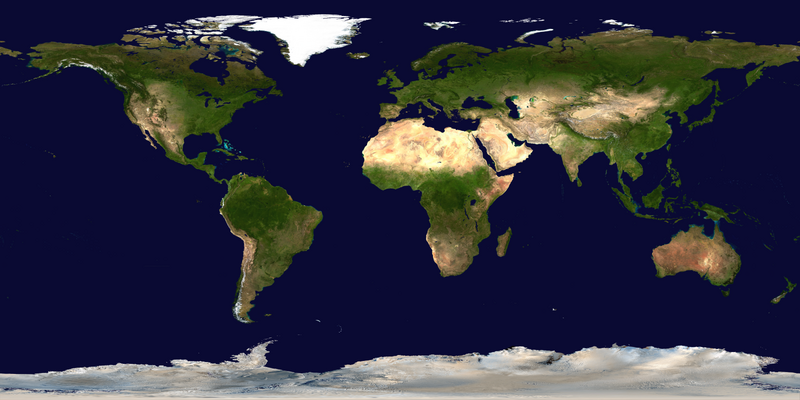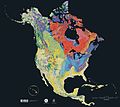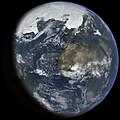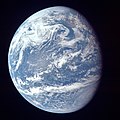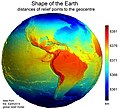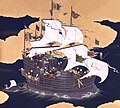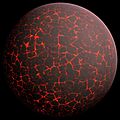Portal:World
The World Portal

The world is the totality of entities, the whole of reality, or everything that exists. The nature of the world has been conceptualized differently in different fields. Some conceptions see the world as unique while others talk of a "plurality of worlds". Some treat the world as one simple object while others analyze the world as a complex made up of parts.
In scientific cosmology, the world or universe is commonly defined as "[t]he totality of all space and time; all that is, has been, and will be". Theories of modality talk of possible worlds as complete and consistent ways how things could have been. Phenomenology, starting from the horizon of co-given objects present in the periphery of every experience, defines the world as the biggest horizon or the "horizon of all horizons". In philosophy of mind, the world is contrasted with the mind as that which is represented by the mind. Theology conceptualizes the world in relation to God, for example, as God's creation, as identical to God or as the two being interdependent. In religions, there is a tendency to downgrade the material or sensory world in favor of a spiritual world to be sought through religious practice. A comprehensive representation of the world and our place in it, as is found in religions, is known as a worldview. Cosmogony is the field that studies the origin or creation of the world while eschatology refers to the science or doctrine of the last things or of the end of the world.
In various contexts, the term "world" takes a more restricted meaning associated, for example, with the
Selected articles -
-
reference book published annually, listing world records both of human achievements and the extremes of the natural world. The brainchild of Sir Hugh Beaver, the book was co-founded by twin brothers Norris and Ross McWhirter in Fleet Street, London, in August 1955.)
The first edition topped the bestseller list in the United Kingdom by Christmas 1955. The following year the book was launched internationally, and as of the 2024 edition, it is now in its 69th year of publication, published in 100 countries and 23 languages, and maintains over 53,000 records in its database. (Full article... -
Global citizenship is a form of transnationality, specifically the idea that one's identity transcends geography or political borders and that responsibilities or rights are derived from membership in a broader global class of "humanity". This does not mean that such a person denounces or waives their nationality or other, more local identities, but that such identities are given "second place" to their membership in a global community. Extended, the idea leads to questions about the state of global society in the age of globalization.
In general usage, the term may have much the same meaning as "world citizen" or cosmopolitan, but it also has additional, specialized meanings in differing contexts. Various organizations, such as the World Service Authority, have advocated global transnational citizenship. (Full article...) -
General images -
The following are images from various world-related articles on Wikipedia.-
Artist's impression of Earth during the later Archean, the largely cooled planetary crust and water-rich barren surface, marked by volcanoes and continents, features already round microbialites. The Moon, still orbiting Earth much closer than today and still dominating Earth's sky, produced strong tides. (from History of Earth)
-
Geologic map of North America, color-coded by age. From most recent to oldest, age is indicated by yellow, green, blue, and red. The reds and pinks indicate rock from the Archean.
-
A reconstruction of human history based on fossil data. (from History of Earth)
-
A pillar at Göbekli Tepe
-
Florence, birthplace of the Italian Renaissance
-
Chloroplasts in the cells of a moss (from History of Earth)
-
First airplane, the Wright Flyer, flew on 17 December 1903.
-
An artist's impression of ice age Earth at glacial maximum. (from History of Earth)
-
Dinosaurs were the dominant terrestrial vertebrates throughout most of the Mesozoic (from History of Earth)
-
Tiktaalik, a fish with limb-like fins and a predecessor of tetrapods. Reconstruction from fossils about 375 million years old. (from History of Earth)
-
Obelisk of Axum, Ethiopia
-
Vitruvian Man by Leonardo da Vinci epitomizes the advances in art and science seen during the Renaissance. (from History of Earth)
-
The pale orange dot, an artist's impression of the early Earth which might have appeared orange through its hazy methane rich prebiotic second atmosphere. Earth's atmosphere at this stage was somewhat comparable to today's atmosphere of Titan. (from History of Earth)
-
Artist's rendition of an oxinated fully-frozen Snowball Earth with no remaining liquid surface water. (from History of Earth)
-
Pangaea was a supercontinent that existed from about 300 to 180 Ma. The outlines of the modern continents and other landmasses are indicated on this map. (from History of Earth)
-
Olmec colossal head, now at the Museo de Antropología de Xalapa
-
A schematic view of Earth's magnetosphere with solar wind flowing from left to right (from Earth)
-
"Lucy", the first Australopithecus afarensis skeleton found, was only 1.06 m (3 ft 6 in) tall.
-
An artist's rendering of a protoplanetary disk (from History of Earth)
-
Artist's impression of the enormous collision that probably formed the Moon (from History of Earth)
-
Image of the physical world, captured by the Hubble Space Telescope (from World)
-
The replicator in virtually all known life isdeoxyribonucleic acid. DNA is far more complex than the original replicator and its replication systems are highly elaborate. (from History of Earth)
-
A computer-generated image mapping the prevalence ofartificial satellites and space debris around Earth in geosynchronous and low Earth orbit (from Earth)
-
Cross-section through a liposome (from History of Earth)
-
Angkor Wat temple complex, Cambodia, early 12th century
-
Tracy Caldwell Dyson, a NASA astronaut, observing Earth from the Cupola module at the International Space Station on 11 September 2010 (from Earth)
-
Great Pyramids of Giza, Egypt
-
A map ofoceanic ridges (from Earth)
-
A view of Earth with itsglobal ocean and cloud cover, which dominate Earth's surface and hydrosphere; at Earth's polar regions, its hydrosphere forms larger areas of ice cover. (from Earth)
-
Pale orange dot, an artist's impression of Early Earth, featuring its tinted orange methane-rich early atmosphere (from Earth)
-
Shanghai. China urbanized rapidly in the 21st century.
-
Lithified stromatolites on the shores of Lake Thetis, Western Australia. Archean stromatolites are the first direct fossil traces of life on Earth. (from History of Earth)
-
View of Earth from the Moon by the Lunar Reconnaissance Orbiter (from Earth)
-
An animation of the changing density ofocean surface (low in purple; high in yellow) (from Earth)
-
A composite image of Earth, with its different types of surface discernible: Earth's surface dominating Ocean (blue), Africa with lush (green) to dry (brown) land and Earth's polar ice in the form of Antarctic sea ice (grey) covering the Antarctic or Southern Ocean and the Antarctic ice sheet (white) covering Antarctica. (from Earth)
-
Taj Mahal, Mughal Empire, India
-
Graph showing range of estimated partial pressure of atmospheric oxygen through geologic time (from History of Earth)
-
A composite image of artificial light emissions at night on a map of Earth (from Earth)
-
A 580 million year old fossil ofCambrian Explosion. (from History of Earth)
-
A banded iron formation from the 3.15 Ga Moodies Group, Barberton Greenstone Belt, South Africa. Red layers represent the times when oxygen was available; gray layers were formed in anoxic circumstances. (from History of Earth)
-
Earth's western hemisphere showing topography relative to Earth's center instead of tomean sea level, as in common topographic maps (from Earth)
-
Artist's conception of Devonian flora (from History of Earth)
-
Change in average surface air temperature and drivers for that change. Human activity has caused increased temperatures, with natural forces adding some variability. (from Earth)
-
Benin Bronze head from Nigeria
-
Battle during the 1281 Mongol invasion of Japan
-
Persepolis, Achaemenid Empire, 6th century BCE
-
Satellite time lapse imagery of Earth's rotation showing axis tilt (from Earth)
-
Earth's land use for human agriculture in 2019 (from Earth)
-
Chennakesava Temple, Belur, India
-
Earth's history with time-spans of the eons to scale (from History of Earth)
-
Fall of the Berlin Wall, 1989
-
Peopling of the world, the Southern Dispersal scenario
-
Japanese depiction of a Portuguese carrack. European maritime innovations led to proto-globalization.
-
Artist's conception ofHadean Eon Earth, when it was much hotter and inhospitable to all forms of life. (from History of Earth)
-
Empires of the world in 1898
-
Yggdrasil, an attempt to reconstruct the Norse world tree which connects the heavens, the world, and the underworld. (from World)
-
Ming dynasty section, Great Wall of China
-
Standing Buddha from Gandhara, 2nd century CE
-
A 2012 artistic impression of the early Solar System's protoplanetary disk from which Earth and other Solar System bodies were formed (from Earth)
-
Artist's impression of a Hadean landscape with the relatively newly formed Moon still looming closely over Earth and both bodies sustaining strong volcanism. (from History of Earth)
-
Notre-Dame de Paris, France
-
Earth's axial tilt causing different angles of seasonal illumination at different orbital positions around the Sun (from Earth)
-
A reconstruction of Pannotia (550 Ma). (from History of Earth)
-
Earth's night-side upper atmosphere appearing from the bottom as bands of afterglow illuminating the troposphere in orange with silhouettes of clouds, and the stratosphere in white and blue. Next the mesosphere (pink area) extends to the orange and faintly green line of the lowest airglow, at about one hundred kilometers at the edge of space and the lower edge of the thermosphere (invisible). Continuing with green and red bands of aurorae stretching over several hundred kilometers. (from Earth)
-
Trilobites first appeared during the Cambrian period and were among the most widespread and diverse groups of Paleozoic organisms. (from History of Earth)
-
Byzantine civilization
-
Last Moon landing: Apollo 17 (1972)
-
An artist's impression of the Archean, the eon after Earth's formation, featuring round stromatolites, which are early oxygen-producing forms of life from billions of years ago. After the Late Heavy Bombardment, Earth's crust had cooled, its water-rich barren surface is marked by continents and volcanoes, with the Moon still orbiting Earth half as far as it is today, appearing 2.8 times larger and producing strong tides. (from Earth)
-
A view of Earth with different layers of its atmosphere visible: thestratospheric blue sky at the horizon, and a line of green airglow of the lower thermosphere around an altitude of 100 km, at the edge of space (from Earth)
-
Great Mosque of Kairouan, Tunisia, founded 670 CE
-
Machu Picchu, Inca Empire, Peru
-
Ajloun Castle, Jordan
Megacities of the world -
Beijing is anational capital regionof China.second busiest airport in the world (2010–2019). In 2020, the Beijing subway was the fourth busiest and second longest in the world. The Beijing Daxing International Airport, Beijing's second international airport, is the largest single-structure airport terminal in the world. (Full article...)Did you know -

- ... that the 1653 hymn "Du, o schönes Weltgebäude", about renouncing the world, contains the stanza "Komm, O Tod, du Schlafes Bruder", which Bach used to conclude his cross-staff cantata?
- ... that the McLaren MCL36, McLaren's 2022 Formula One car, has been in development since 2019 because of the pandemic's interruptions to the sport?
- ... that the Leedy Manufacturing Company of Indianapolis, Indiana, was at one point the largest manufacturer of drums in the world?
- ... that the Brazilian cruiser Almirante Barroso was on a voyage to circumnavigate Earth with Prince August Leopold on board when the republic was proclaimed in Brazil?
- ... that museum director Alena Aladava rebuilt the Belarusian national art collection in the aftermath of the Second World War?
- ... that neither holochess (dejarik) nor sabacc, two games invented for the Star Wars films, have a definitive ruleset despite several real-world licensed releases?
- ... that Nazi war criminal Kurt Weigelt could not be directly employed by Deutsche Bank after World War II, so he reestablished Lufthansa?
- ... that in 2021 Krisztofer Mészáros became the first Hungarian male gymnast in 22 years to qualify for a World Artistic Gymnastics Championships all-around final?
Countries of the world -

The part of Africa now known as Malawi was settled around the 10th century byChichewa and Chitumbuka), officially the Republic of Malawi and formerly known as Nyasaland, is a landlocked country in Southeastern Africa. It is bordered by Zambia to the west, Tanzania to the north and northeast, and Mozambique to the east, south and southwest. Malawi spans over 118,484 km2 (45,747 sq mi) and has an estimated population of 19,431,566 (as of January 2021). Malawi's capital and largest city is Lilongwe. Its second-largest is Blantyre, its third-largest is Mzuzu and its fourth-largest is its former capital, Zomba. It was the first capital city of Malawi before being changed to Lilongwe.V-Dem Democracy indices Malawi is ranked 74th electoral democracy worldwide and 11th electoral democracy in Africa. The country's military, the Malawian Defence Force, includes an army, a navy, and an air wing. Malawi's foreign policy is pro-Western. It maintains positive diplomatic relations with most countries, and participates in several international organisations, including the United Nations, the Commonwealth of Nations, the Southern African Development Community (SADC), the Common Market for Eastern and Southern Africa (COMESA), and the African Union (AU). (Full article...)The Seven Wonders of Wales (Welsh: Saith Rhyfeddod Cymru) is a traditional list of notable landmarks in north Wales, commemorated in an anonymously written rhyme:
The rhyme is usually supposed to have been written sometime in the late 18th or early 19th century by an English visitor to North Wales. The specific number of wonders may have varied over the years: the antiquary Daines Barrington, in a letter written in 1770, refers to Llangollen Bridge as one of the "five wonders of Wales, though like the seven wonders of Dauphiny, they turn out to be no wonders at all out of the Principality". (Full article...)Related portals
-
Protected areas of the world -
-
Full article...)
-
The Protected areas of New South Wales include both terrestrial and marine protected areas. there are 225 national parks in New South Wales. A number established since the late 1970s followed campaigns by local residents and environmentalists.
Based on the Collaborative Australian Protected Area Database (CAPAD) 2020 data there are 2136 separate terrestrial protected areas with a total land area of 7,696,641 hectares (19,018,810 acres) (9.61% of the state's area). CAPAD data also shows 18 marine protected areas with a total area of 348,849 hectares (862,020 acres), covering 39.63% of NSW waters. (Full article...) -
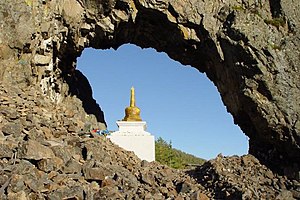
"Temple Gate" Rock formation at Alkhanay National Park
Protected areas of Russia, (official Russian title: Russian: Особо охраняемые природные территории, literally "Specially Protected Natural Areas"), is governed by the corresponding 1995 law of the Russian Federation. (Full article...) -
Full article...)
-
This is a list of protected areas of Ontario that are administered by Government of Ontario. Ontario Parks and the Ministry of the Environment, Conservation and Parks are the provincial bodies responsible for managing these protected areas. (Full article...)
-
Full article...)
-
This is a list of protected areas in Botswana. (Full article...)
-
Polish Parliament: (Full article...)
-
This is a list ofVitosha Nature Park, established in 1934. All of the nationally protected areas in Bulgaria are also part of the Natura 2000 network of protected natural areas in the territory of the European Union. Bulgaria has some of the largest Natura 2000 areas in the European Union covering 33.8% of its territory.)
- Parks and reserves in italic letters are part of Global 200 ecoregions.
-
Full article...)
-
Tijuca Forest National Park)
Protected areas of Brazil included various classes of area according to the National System of Nature Conservation Units (SNUC), a formal, unified system for federal, state and municipal parks created in 2000. (Full article... -
Tasmania Parks & Wildlife Service (about 42% of total Tasmanian land area). Marine protected areas cover about 7.9% of state waters.)
Within each classification of reserve there may be a variation of IUCN categories Australia is a signatory to the Convention of Biological Diversity and as such has obligations to report the status of its National Reserve System.IUCN provides on its website a prescription for activities consistent with the categorisation system. Changes made to the Nature Conservation Act 2002 in 2014 permit timber harvesting. These changes made in addition to the already established right to access minerals means that many of the IUCN categorisations assigned to individual reserves in Tasmania are no longer fit for purpose. In addition many reserves have had their reserve status downgraded from a class excluding timber harvesting and mineral extraction to ones where these activities are now permitted. This mis-application of the IUCN protected area categories needs to be remedied or the reserves protected land class under the Nature Conservation Act 2002 should be adjusted to reflect its currently assigned IUCN category. (Full article... -
Papua New Guinea is home to several protected areas, which receive protection because of their environmental, cultural or similar value.
The total area of Papua New Guinea protected territories is 14,330 km2 (5,530 sq mi), which amounts to approximately 3.07% of the country's territory. The total number of protected areas as 2018 is 71. (Full article...) -
Protected areas of Libya include any geographical area protected for a specific use.
Most protected areas are intended for the conservation of flora and fauna. Libya's national parks and nature reserves are maintained by the "Technical Committee of Wildlife and National Parks" which was created in 1990, as part of the General Secretariat of Agricultural Reclamation and Land Reform. (Full article...) -
Forests in the state ofFull article...)
Selected world maps
-
United Nations Human Development Index map by country (2016)
-
Index map from the International Map of the World (1:1,000,000 scale)
-
A plate tectonics map with volcano locations indicated with red circles
-
Only a few of the largestlarge igneous provinces appear (coloured dark purple) on this geological map, which depicts crustal geologic provinces as seen in seismic refractiondata
-
1516 map of the world by Martin Waldseemüller
-
Mollweide projection of the world
-
The world map by Gerardus Mercator (1569), the first map in the well-known Mercator projection
-
Time zones of the world
-
The Goode homolosine projection is a pseudocylindrical, equal-area, composite map projection used for world maps.
World records
- List of Olympic records in athletics
- List of world records in athletics
- List of junior world records in athletics
- List of world records in masters athletics
- List of world youth bests in athletics
- List of IPC world records in athletics
- List of world records in canoeing
- List of world records in chess
- List of cycling records
- List of world records in track cycling
- List of world records in finswimming
- List of world records in juggling
- List of world records in rowing
- List of world records in speed skating
- List of world records in swimming
- List of IPC world records in swimming
- List of world records in Olympic weightlifting
Topics
Categories
Wikimedia
The following Wikimedia Foundation sister projects provide more on this subject:
-
Commons
Free media repository -
Wikibooks
Free textbooks and manuals -
Wikidata
Free knowledge base -
Wikinews
Free-content news -
Wikiquote
Collection of quotations -
Wikisource
Free-content library -
Wikispecies
Directory of species -
Wikiversity
Free learning tools -
Wikivoyage
Free travel guide -
Wiktionary
Dictionary and thesaurus

